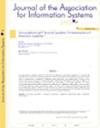Technology Lifecycles and Digital Technologies: Patterns of Discourse across Levels of Materiality
IF 5.5
3区 管理学
Q1 COMPUTER SCIENCE, INFORMATION SYSTEMS
引用次数: 0
Abstract
The technology lifecycle model is extensively used to study technology evolution and innovation. However, this model was developed for industrial-age material technologies and does not address digital technologies with nonmaterial elements. Therefore, a question emerges as to whether the level of technological materiality is implicated in different dynamics of innovation, as reflected in the technology lifecycle. Digital technologies evolve through discourse that involves interactions among multiple stakeholders that shape the evolutionary trajectory of the technology. Therefore, we set out to examine whether discourse about digital technologies that vary in their level of materiality manifests in different ways throughout these technologies’ lifecycles. To do so, we conducted a study comparing the discourse around 10 digital technologies—five highly material and five highly nonmaterial—at different stages of their technology lifecycles. We identified three characteristics of discourse—volume, volatility, and diversity—and examined them for the 10 digital technologies by analyzing their corresponding Wikipedia articles. Our findings show that the discourse around technologies with different levels of materiality is similar in the initial era of the lifecycle but diverges in the two subsequent eras. In addition, we found that the discourse around highly nonmaterial technologies remains elevated for longer time periods, compared to highly material technologies. Based on these results, we put forth propositions that challenge and extend existing research on the relationships between the technological level of materiality, discourse, and trajectories of technology evolution.技术生命周期与数字技术:跨物质层面的话语模式
技术生命周期模型被广泛用于研究技术演进和创新。然而,这个模型是为工业时代的材料技术开发的,并没有解决非物质元素的数字技术。因此,出现了一个问题,即技术重要性的水平是否涉及不同的创新动态,反映在技术生命周期中。数字技术是通过话语进化的,话语涉及多个利益相关者之间的互动,这些利益相关者塑造了技术的进化轨迹。因此,我们着手研究关于数字技术的话语在其重要性水平上的差异是否在这些技术的生命周期中以不同的方式表现出来。为此,我们进行了一项研究,比较了10种数字技术在其技术生命周期的不同阶段的话语——五种高度物质性和五种高度非物质性。我们确定了话语的三个特征——数量、波动性和多样性,并通过分析10种数字技术对应的维基百科文章来检验它们。我们的研究结果表明,围绕不同物质水平的技术的话语在生命周期的初始时代是相似的,但在随后的两个时代则有所不同。此外,我们发现,与高度物质性的技术相比,围绕高度非物质性技术的讨论在更长的时间内仍然处于高位。基于这些结果,我们提出了挑战和扩展现有的关于物质性技术水平、话语和技术进化轨迹之间关系的研究的命题。
本文章由计算机程序翻译,如有差异,请以英文原文为准。
求助全文
约1分钟内获得全文
求助全文
来源期刊

Journal of the Association for Information Systems
工程技术-计算机:信息系统
CiteScore
11.20
自引率
5.20%
发文量
33
审稿时长
>12 weeks
期刊介绍:
The Journal of the Association for Information Systems (JAIS), the flagship journal of the Association for Information Systems, publishes the highest quality scholarship in the field of information systems. It is inclusive in topics, level and unit of analysis, theory, method and philosophical and research approach, reflecting all aspects of Information Systems globally. The Journal promotes innovative, interesting and rigorously developed conceptual and empirical contributions and encourages theory based multi- or inter-disciplinary research.
 求助内容:
求助内容: 应助结果提醒方式:
应助结果提醒方式:


